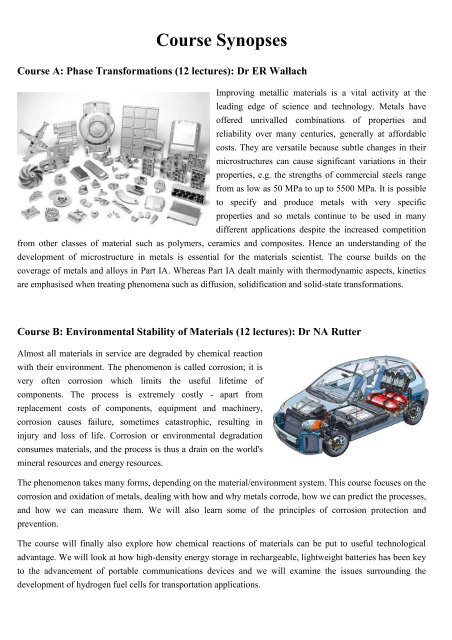Natural Sciences Tripos Part IA - Department of Materials Science ...
Natural Sciences Tripos Part IA - Department of Materials Science ...
Natural Sciences Tripos Part IA - Department of Materials Science ...
Create successful ePaper yourself
Turn your PDF publications into a flip-book with our unique Google optimized e-Paper software.
Course SynopsesCourse A: Phase Transformations (12 lectures): Dr ER WallachImproving metallic materials is a vital activity at theleading edge <strong>of</strong> science and technology. Metals have<strong>of</strong>fered unrivalled combinations <strong>of</strong> properties andreliability over many centuries, generally at affordablecosts. They are versatile because subtle changes in theirmicrostructures can cause significant variations in theirproperties, e.g. the strengths <strong>of</strong> commercial steels rangefrom as low as 50 MPa to up to 5500 MPa. It is possibleto specify and produce metals with very specificproperties and so metals continue to be used in manydifferent applications despite the increased competitionfrom other classes <strong>of</strong> material such as polymers, ceramics and composites. Hence an understanding <strong>of</strong> thedevelopment <strong>of</strong> microstructure in metals is essential for the materials scientist. The course builds on thecoverage <strong>of</strong> metals and alloys in <strong>Part</strong> <strong>IA</strong>. Whereas <strong>Part</strong> <strong>IA</strong> dealt mainly with thermodynamic aspects, kineticsare emphasised when treating phenomena such as diffusion, solidification and solid-state transformations.Course B: Environmental Stability <strong>of</strong> <strong>Materials</strong> (12 lectures): Dr NA RutterAlmost all materials in service are degraded by chemical reactionwith their environment. The phenomenon is called corrosion; it isvery <strong>of</strong>ten corrosion which limits the useful lifetime <strong>of</strong>components. The process is extremely costly - apart fromreplacement costs <strong>of</strong> components, equipment and machinery,corrosion causes failure, sometimes catastrophic, resulting ininjury and loss <strong>of</strong> life. Corrosion or environmental degradationconsumes materials, and the process is thus a drain on the world'smineral resources and energy resources.The phenomenon takes many forms, depending on the material/environment system. This course focuses on thecorrosion and oxidation <strong>of</strong> metals, dealing with how and why metals corrode, how we can predict the processes,and how we can measure them. We will also learn some <strong>of</strong> the principles <strong>of</strong> corrosion protection andprevention.The course will finally also explore how chemical reactions <strong>of</strong> materials can be put to useful technologicaladvantage. We will look at how high-density energy storage in rechargeable, lightweight batteries has been keyto the advancement <strong>of</strong> portable communications devices and we will examine the issues surrounding thedevelopment <strong>of</strong> hydrogen fuel cells for transportation applications.
















